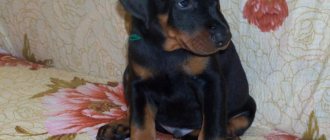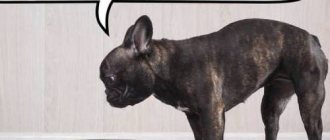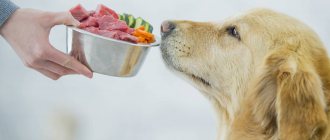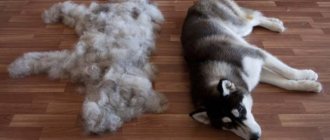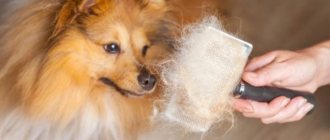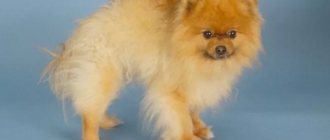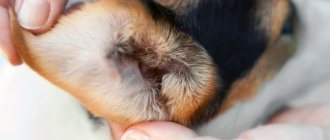The Spitz breed requires special care . Constant monitoring of the condition is required.
In some cases, this will help prevent certain diseases . For example, tears act as a natural eye cleanser, but increased fluidity is not the norm.
Causes of lacrimation
If a Spitz's eyes are watery, then we are talking about a condition called epiphora. The essence of the eye problem is obstruction of the tear ducts.
The tear, having washed the eyeball, is collected in a special bag and passes through the canals into the nose. When the ducts become obstructed, excess tears leak out through the edge of the lower eyelid and flow down the muzzle. This may happen constantly or periodically.
The liquid colors the Spitz's fur with a characteristic brown color. This occurs from the oxidation of substances that make up the tear fluid.
The lacrimation can be so severe that the skin is constantly wet, the fur becomes matted, and eczema appears. In this case, the dog experiences discomfort and begins to rub the problem area with its paws, damaging the mucous tissues and skin in neighboring areas.
Lacrimation is not a separate ailment, but a symptom of some kind of Spitz disease.
The causes of epiphora are various. The most common:
- Congenital or acquired obstruction of the nasolacrimal canal. Absence of lacrimal openings or their reduced size.
- Dacryocystitis (inflammation of the lacrimal sac).
- Turning of the eyelids.
- Districhiasis.
- Conjunctivitis.
In addition to the above diseases, the condition in a dwarf breed dog can be caused by:
- eyelid tumor,
- uveitis;
- inflammation of teeth;
- the presence of a foreign body in the eyeball;
- keratitis (inflammation of the cornea);
- inflammation of the eyelids (blepharitis) - when crusts, scales, and pustules appear.
All pathologies are characterized by profuse secretion of tears due to contact irritation or pain.
Why are they tearing up a little?
There are many reasons why a Spitz may have watery eyes:
- thick hair that is located next to them irritates the mucous membrane;
- Due to their short stature, dust or debris may get into their eyes when walking. Wind and heat also cause tearing;
- eyeball injury;
- heredity;
- allergic reaction to feed additives;
- an ear infection that affects the eye canal;
- dust getting on the eyeball and improper care of the pet lead to the development of infections that take a long time and are difficult to treat;
- poor nutrition.
Clean, shiny and clear eyes are an indicator of a dog's health.
If there is no pus, and only tears flow from the eye, then it is possible that the Spitz’s hair is simply not growing properly. Reference! Tearfulness may increase after a walk and sleep; this reaction is considered normal, so there is no need to worry about it.
It's not scary if the discharge is not strong. It is necessary to take action only in cases where they begin to increase. Moist areas under the eyes become an excellent breeding ground for bacteria that can cause more serious harm to your pet's health.
Entropion of the eyelids
If a Spitz's eyes are running, then perhaps the reason is related to a pathology such as entropion of the eyelids. The edge of the eyelid with the eyelashes is strongly turned inward and rubs the eyes of the spitz. This causes discomfort to the pet. Symptoms of the disease:
- the dog squints;
- constantly rubs the area of the eye sockets with its paws;
- blinks frequently;
- possible presence of conjunctivitis;
- eyes are streaming.
Pomeranians, including the bear type, are among the breeds prone to entropion.
Most often, the disease manifests itself in puppies (about 6 months), but signs may also appear later - at one year of age.
The main method of treatment is surgery. Eyelid surgery is performed after 6 months of age, as it is possible that the condition will improve.
After the operation, it is necessary to care for the Spitz's eyes for a long time, using drops and ointments prescribed by the doctor.
Districhiasis
Another problem with the eyes of Pomeranians is that the eyelids may grow an extra row of eyelashes or they may be abnormally positioned. The disease is called districhiasis.
Hairs have an impact on the cornea, causing irritation, redness, lacrimation, and discomfort. Most often, incorrectly growing eyelashes are found on the upper eyelid.
There are several treatment options:
- Removal with tweezers. However, there is no guarantee that they will not grow again.
- Laser burning of hairs and bulbs. The procedure is performed under anesthesia.
- If there are a large number of eyelashes – surgical removal.
What you absolutely cannot do is try to solve the problem yourself.
Proper use of anti-tear products
In order not to harm your pet, you need to use the prescribed eye products correctly.
- Before any procedure performed on an animal's eyes, you should wash your hands.
- Before instilling drops or another product, you need to clean the hair around the eye. This can be done with a damp cotton swab;
- When using eye products to treat excessive tearing, the pet's head should be tilted back and held firmly with one hand.
- The ointment should be placed behind the eyelid;
- If only one eye of an animal is leaking, all means prescribed for prevention or therapy must be used on both eyes.
You need to remember that the dog must live in a clean environment and receive proper care - this simple rule will help avoid many problems associated with the health of your beloved pet.
Conjunctivitis
The disease is complex in nature. Viruses, fungi, chlamydia, mechanical stress, allergies, grains of sand, and dust can cause inflammation.
With conjunctivitis, the mucous layer covering the apple and the inner surface of the eyelids becomes inflamed.
Symptoms:
- redness of the mucous membrane, swelling of the eyelids;
- initially clear, then brown discharge from the eyes;
- closing of eyelids.
Often the cause of conjunctivitis in Spitz is obstruction of the nasolacrimal duct. Stagnant tears are a beneficial environment for the development of pathogenic microflora.
If your eyes are watery and there is purulent yellow-green discharge, then these are signs of purulent conjunctivitis. It is provoked by staphylococci and streptococci, which are natural inhabitants of the animal's lacrimal sac.
Under the influence of various factors, and more often it is weak immunity, they are activated. Therefore, it is important not to treat your pet yourself with the use of local antibiotics, since there is a high risk of developing chronic conjunctivitis or more serious diseases: keratoconjunctivitis, keratitis.
At the first signs of conjunctivitis, you should consult a doctor as soon as possible. If it is not possible to quickly get to a veterinary clinic, you can wipe the pus from your eyes. To do this, use a gauze swab dipped in a special care liquid: Diamond Eyes, Globalvet, Tsiprovet. This will make your pet feel better.
Adaptation of a puppy to a new family.
So, the baby has crossed the threshold of your home for the first time. You are surprised how calmly he endured the journey, has already become attached to you and feels quite confident in the new place, since in the Donik Style nursery great attention is paid to the psyche in breeding work and at the rearing stage.
But despite this, do not forget that everything is completely new for the child! It is very important to surround the little member of your family with as much love and care as possible from the first minute! You shouldn’t punish your baby at all during the first week; it’s enough to simply calmly explain what is required of him and encourage correct behavior (we’ll talk about suitable treats later).
Try to spend as much time with him as possible, pick him up at every opportunity (don’t forget the main thing yourself and be sure to remind your children that under no circumstances should you lift a puppy, just like an adult dog, by the paws or under the armpits, where the delicate ligaments are located) . Don’t be shy to talk to a Japanese person and don’t doubt that he understands you, despite the fact that he still knows few words. Remember, dogs do not communicate verbally, so it doesn’t matter what language you speak, what matters is how you do it, what gestures and intonations you use to reinforce your speech, and what you want to convey.
Immediately from the road, pour water, show the place, give toys and after a short time feed the baby. Place a diaper on the place where he goes to the toilet; in the future, if necessary, it can be moved to where it is convenient. When the need arises to leave the little one alone, unattended, be sure to make sure that he does not have access to anything that can be chewed and choked, be it slippers, any soft things, household appliances, and especially live wires. Don’t forget, when teeth grow, they itch, and the most unexpected things can come into play!
If at this stage you still have questions or the puppy’s behavior worries you, be sure to contact us!
Inflammatory process
The most common reason why a Spitz puppy has watery eyes is dacryocystitis. Inflammation appears in puppies at the age of 6-8 months. The cause of the disease is congenital obstruction of the lacrimal sac, as well as the ingress of foreign objects. For example, small plant seeds can enter the lacrimal sac during a walk and cause inflammation.
The disease is manifested by the following symptoms:
- soreness;
- swelling at the inner corner of the eye;
- tearfulness;
- involuntary blinking.
[/su_list] If a foreign body gets in, to prevent your eyes from watering, you need to rinse. The procedure is performed by a doctor.
In older Spitz dogs, inflammation is often caused by a tumor in the nose or eye.
Tags
Dog breeds for dogs for dogs in Dog grooming Dog nutrition for dogs Dog breeds for dogs for dogs in Dog grooming watery eyes watery eyes watery eyes watery eyes Dog breeds from breeds Large breeds Medium breeds Small breeds Dog breeds from breeds Large breeds Medium breeds avoid watery eyes watery eyes cause watery eyes in Causes of watery eyes Causes of watery eyes Watery eyes may
catscatsrodentsquestionsmenubirdslifeeducationtrashsitecommentssmall nicknamesauthorsdoctorterrieraverage
Pathologies associated with tear drainage
Congenital pathologies in Spitz dogs include abnormal development/curvature of the lacrimal canals and underdevelopment of lacrimal openings or their absence. In the absence of both lacrimal openings, lacrimation is constant. The canals become clogged and the danger is that bacteria and mucus can accumulate in them, as evidenced by purulent discharge. The problem may not only be congenital. It can be caused by the following reasons:
- previous injuries;
- infection;
- oncology, when a tumor blocks the passage for tear fluid.
Poor orange nutrition or poor food does not affect the outflow of tears and their production.
Diagnosis and treatment
If your Spitz's eyes are running, red-brown tracks have formed on its face, the skin around the eye sockets is irritated, and the discharge has an unpleasant odor - this is a serious reason to consult a veterinarian.
The doctor carefully examines the dog. Therapy is prescribed after finding out the reasons why the Spitz's tears flow.
If debris gets in, it is enough to flush the duct to remove the foreign body. If an infection is suspected, a laboratory analysis of eye discharge is performed.
If the problem is related to allergies, the main thing is to eliminate the irritant. However, it is often difficult to establish it, since it can be pollen, dust, or food.
A fluorescein test is required to check the patency of the ducts. If the dog's nose turns green, the patency of the nasolacrimal duct is normal.
In a miniature Spitz, due to the structure of the facial part of the skull (it is short), the tear ducts are strongly curved. Their shape resembles the English letter S. If it is determined that the Spitz’s eyes are watery due to pathology of the canals, they are washed in a veterinary clinic.
In the absence of positive dynamics, surgical restoration of patency is indicated. The operation is complex and requires a long recovery period. The dog is fitted with a catheter for at least 1.5 months.
What to do?
Unless there is a specific reason, try not to use medications.
When tears are caused by debris, it must be removed as carefully as possible using a cotton swab. Then you should rinse the eye from the outer corner to the nose.
If lacrimation occurs due to the fur on the face, then grooming is necessary.
Important! Don't forget about eye care! Wipe them daily for your pet with a cotton pad soaked in warm water. The water must be boiled.
You can also use silver water for care. It is easy to prepare. Place any silver item in a glass of distilled water and let it sit for a day before you start using it.
It is not advisable to use folk care products. For example, you should not rub your eyes with tea bags. It is better to use Chamomile lotion. Its antimicrobial properties will eliminate redness and reduce swelling. They can also be used for preventive purposes.
Before a walk, put in special drops that will help prevent tearing from weather conditions.
Analyze your pet's menu. It is necessary to exclude sweets from it, which are very harmful for dogs. Fatty and fried foods should also be excluded from the diet.
If the discharge does not go away after a few days, take the animal to the doctor. Sometimes even the simplest situations without timely intervention from a specialist can lead to clouding of the cornea and loss of vision.
Attention! Before showing your Spitz to the doctor, do not rub his eyes with medications that contain antibiotics.


